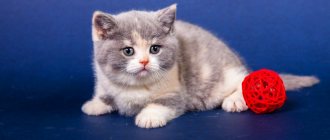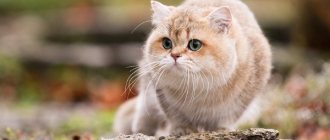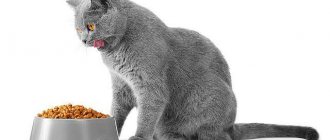The development of kittens occurs quite intensively in the first months of life; their structure and nutrition undergo many changes. And this time of growth of a kitten is considered the most important in its development and formation, so you need to do everything correctly and, most importantly, on time!
The article contains a lot of useful information: up to what age does the growth of a cat and the growth of cats continue, the size of the cat and what size the cat will be in each month of its life, the development of a kitten by month: stages of kitten development (kitten development calendar), the growth of kittens by week, weight kittens by month, the behavior of kittens in each period of development, how to raise a kitten so that it grows up social, when kittens open their eyes and much, much more.
The development of a cat and the development of a cat are slightly different; a cat does not gain weight as rapidly, however, as a rule, cats are more curious and active than males. But in general, everything happens at the same time, without serious lags on both sides. The development and growth of kittens by month in the table will help determine the age of your pet!
UNTIL WHAT AGE WILL KITTENS REMAIN BABIES? HOW MANY MONTHS WILL THE KITTEN BE A KITTEN?
Determining the age of a kitten: if you want to determine the age of a kitten based on external data and characteristics, carefully study the table and find the characteristics that match your pet. Determining how many months a kitten is is quite simple, because a kitten changes a lot every month. Here are the characteristics that you should pay attention to to find out how many months a kitten is: weight and size of kittens by month, teeth (baby, permanent, or during the period of teeth change), fur and undercoat, eye color, behavior. So how do you find out the age of a kitten? Read the description in the table and compare!
Also, how to find out how many months a kitten is and how to determine the age of a kitten will be helped by a photo.
SEE THE STAGES OF KITTEN DEVELOPMENT IN THE KITTEN GROWTH TABLE
Let's consider all stages of development of kittens from birth to one year, their characteristics of maturation and growth, features of care at each age.
NEWBORN KITTENS
A newborn kitten is born weighing 80-120 grams, the size of kittens at birth is body length about 9-12 cm.
Very rarely, but still there are cases of the birth of kittens 50-70g, they are small but active. This does not always serve as a signal that the kitten is sick or has abnormalities. This also occurs in multiple pregnancies or in the case of small parents.
Newborn kittens: photo of the litter Newborn kittens are absolutely helpless during this period, they are blind, deaf, and do not know how to regulate their temperature. Newborn kittens have no undercoat; the fur is thin, weak and does not warm at all.
Newborn British kittens Kittens do not know how to stand on their paws, their bones are very fragile, so babies require special care. At this time, sleep and kittens are almost inseparable concepts. Newborn kittens sleep almost constantly and eat a lot and often. Kittens need sleep for the further development of their nervous system. Newborn kittens also cannot defecate on their own; the mother cat licks their genitals and eats their feces. What is really well developed in newborn kittens is their sense of smell and touch; they easily find their mother’s nipples, fingering them with their paws, sucking and, thereby, stimulating further milk production.
Newborn kittens: photo of the litter During this period, it is better not to touch the kittens at all, just monitor their weight. Kittens should add it daily (about 10-20 grams per day), if the kitten is growing, then everything is in order.
Things to take care of:
- Set up a box for a cat (or organize a maternity house) with newborn kittens. It should be warm and dry there. The bedding should be changed (it is advisable to use white sheets to track the color of the mother cat’s discharge), because The cat will have postpartum discharge. Also, if necessary, you can put a heating pad.
- Cat food. It should be plentiful and balanced; food is a must for nursing cats. Food and water should be freely available, next to the nest box. It is also recommended to place a tray here.
Cats are by nature excellent mothers and may not leave the box for a whole week, so it is important that newborn kittens have enough milk. In the first days, the cat produces colostrum (very fatty, nutritious milk that has antibodies, thanks to which kittens develop lasting immunity).
If there are a lot of kittens, be sure to make sure that each newborn kitten gets its good portion.
The development of kittens after birth (the development of newborn kittens) is very active, so the first week can be planned out day by day.
KITTENS – DEVELOPMENT BY DAY:
1-2 days after birth, a newborn kitten only sucks milk and sleeps.
After 3-4 days, the kitten’s umbilical cord heals and falls off.
After 4-5 days , the kitten’s hearing begins to develop, and you can already observe how it begins to react to loud sounds.
HOW LONG DO KITTENS SLEEP? WHY DOES A KITTEN SLEEP ALL DAY?
If it seems to you that the kitten sleeps all the time, this is most likely normal, and there is no need to worry right away. In the first week, the kitten sleeps about 22 hours a day. Just weigh the kitten daily - this is the best indicator that everything is fine with the baby.
A newborn kitten sleeps up to 22 hours a day. How much a kitten should sleep, he decides for himself, however, if the kitten sleeps constantly and does not gain weight, first of all, pay attention to whether the kitten has enough free nipple (this happens more often if there are 5 or more kittens in a litter) , if the kitten is weak or the last born, apply it to the cat more often and do not let other kittens chase it away. If in this case the kitten behaves sluggishly and does not recover, contact your veterinarian. Kittens from birth to one month change greatly both in appearance and development, and it is important to pay close attention to this in each period. Newborn kittens in the photo, look in the pictures.
KITTEN 1 WEEK
The weight of a kitten at 1 week is 170-280 g. Week-old kittens are already starting to move more. By the end of the first week, kittens' ears open up, allowing them to hear better.
Also in the first week, you can see signs of long hair - small curls appear behind the ears.
Kitten aged 1 week
WHEN DO KITTENS HAVE EYES?
Also, by the end of the first week, the kittens' eyes begin to appear.
When do kittens' eyes open completely? How long does it take for kittens to open their eyes after birth?
Kitten 1 week:
- paws become stronger;
- the kitten sleeps a little less;
- the fur begins to “fluff”;
- the first undercoat begins to emerge;
- the kitten crawls and easily crawls towards the mother 30-50 cm;
The kittens are already a week old, and you are probably already thinking about names for them. Choose names for kittens boys and girls from “A” to “Z” here
Kittens 1 week.
Photo KITTEN 2 WEEKS old
Kittens at 2 weeks of age not only crawl, but also begin to walk, although they do this very shakily, kittens at 2 weeks behave more actively, and release their claws more and more often.
Kitten 2 weeks old: eyes begin to open
The kitten still sleeps a lot, although periods of long sleep are replaced by short periods of wakefulness. The weight of kittens triples at 2 weeks and is approximately 250-350 g. A kitten at two weeks old eats less frequently, but in larger portions, so we continue to monitor the mother cat’s adequate nutrition.
WHEN DO KITTENS' EYES OPEN?
Surely you have already wondered: what time do kittens open their eyes? - The time has come. On days 12-14, kittens open their eyes; the color of the kittens’ eyes is always blue, slightly cloudy. Kittens' eyes have already opened, but kittens begin to see approximately 15-17 days after birth.
Kitten is 2 weeks old: his hearing improves significantly, he responds to the cat’s purring and calling.
Kitten 2 weeks old
A kitten at 2-3 weeks: becomes more curious, increasingly approaches the edge of the box and looks at the world around it.
For photos of kittens at half a month, see the article. The kittens in the photo still look helpless and weak for two weeks.
Kitten with mother aged 2-3 weeks
KITTEN 3 WEEKS
The weight of a kitten at 3 weeks is 350-500 g. Kittens at 3 weeks can already hear and see perfectly, almost like adult cats. Their movements become more confident. A kitten at 3 weeks already begins to hiss and arch its back when it gets scared.
Kitten aged 3 weeks
During this period, kittens are quite active, waking time is about a third of the day. At the age of 3 weeks, kittens already begin to walk more confidently, even try to run and jump, some of them are already falling out of the box. At three weeks old, kittens still have very poor spatial orientation, so make sure that in the room where the box is located there are no objects that could injure the kitten.
At approximately 3 weeks, the first baby teeth begin to appear. When kittens are 3 weeks old, it is recommended to provide them with a litter tray. It is at this time that they begin to learn to go to the toilet on their own. Read how to train a kitten to use a litter box here.
A kitten at the age of 3 weeks already needs socialization, so play with it and pet it so that the kitten grows tame.
From now on, it is necessary to raise the kitten and be sure to achieve positive and 100% results. A kitten at 3 weeks already needs to start complementary feeding. Therefore, it is worth starting to transfer the kitten from mother's milk to soft food. From 3-4 weeks you can give soaked dry food. KITTEN 4 WEEKS - 1 MONTH
Behavior of a kitten at 1 month:
When a kitten is a month old, he behaves very actively, he doesn’t want to sit in a box at all. He flirts with his brothers and sisters, tries to bite, imitating hunting. Important games train kittens' muscles, develop flexibility and mobility.
A 1 month old kitten is very curious, he actively explores the room and finds games for himself. Be careful with sharp parts, because... a kitten can swallow a button, thread, etc.
Also during this period it is worth thinking about mosquito nets for windows, because... kittens begin to show their activity. It is important for owners to provide maximum protection for their children from falling out of the window.
How much does a kitten weigh per month?
The weight of a one-month-old kitten grows significantly and increases three times compared to birth weight. Kittens at the age of 1 month weigh approximately 400-650 grams. Read more about kitten weight here.
Photo - Kitten at 1 month
How long does a one-month-old kitten sleep?
The kitten sleeps for 15-20 hours, gradually the time of one sleep increases (since the kitten later switches to fewer feedings), but the number of hours in sleep remains unchanged.
Kittens at 4 weeks become faster, nimble, they play a lot with each other, release their claws and are already acquiring adult habits.
Scottish fold kitten 1 month old Scottish fold
At 1 month old, a kitten already has good balance, can jump, and also begins to regulate its body temperature.
The kitten is 1 month old and this is the time to actively accustom it to handling; later this will be impossible to do, and the kitten will remain a savage. Therefore, enjoy communicating with kittens, pet them and, of course, play.
When do kittens' eyes change? Do kittens' eyes change at all?
Of course, kittens change eye color gradually, this does not happen in one day, it also often depends on the eye color that the kitten will acquire in the future (green eye color takes the longest to form). Cats' eye color changes completely before they reach 2 years of age. The change in eye color in kittens is called “percoloration.”
On average, a kitten begins to change eye color at 4 weeks.
Kitten is 1 month old
By observing, you can see small inclusions; over time, the color of the kittens’ eyes will completely change from blue to permanent.
At 5 weeks, kittens begin to eat solid food and are much less dependent on their mother's milk. Each kitten should eat 100-150 grams per day. solid food. When it comes to the litter box, this is the most important time to teach them about cleanliness and hygiene. Later this will be much more difficult.
Also, kittens at 5 weeks begin to change their fur pattern, a denser undercoat appears, and the color of the pattern becomes more pronounced and contrasting.
The kitten is one month old and already needs to be dewormed.
Kittens at 1 month in the photo look quite funny, active and bring a lot of positivity. What kittens look like at one month: see photos of kittens at 1 month in pictures.
Kitten 1 month (4 weeks)
KITTEN 1.5 MONTHS - 6 WEEKS
A kitten at one and a half months already begins to wash and lick itself, learns to hunt and develops its skills with its brothers and sisters.
Kittens 1.5 months
A kitten at 6 weeks already has fairly sharp vision and formed eyes: they are pure, clear color. Kittens at 7 weeks already go to the litter box and can find it on their own. A 1.5 month old kitten can already eat solid food. From this period of time, it is necessary to take care of variety in food.
The number of meals should be at least 5 times a day and should remain this way for up to 4-5 months. A kitten at 6-7 weeks should already weigh 550-900g, continuing to actively gain weight. By the end of the kitten's second month, the intake of mother's milk is reduced to a minimum.
There is a misconception that a 1.5 month old kitten can move to a new home, but this is the biggest mistake you can make in the development of a baby. Firstly, kittens still eat their mother’s milk, which is so necessary for the development of strong immunity, and secondly, a kitten at 6-7 weeks still needs training from the mother cat. Yes, indeed, he can already eat on his own and take care of himself, but he will never become a well-mannered, clean, social and healthy cat without his mother during this period.
Also at this time you need to start accustoming to the scratching post. How to do this correctly, read here.
A 6 week old kitten already needs its first vaccination. Plan a trip to the veterinarian and get all the necessary advice on the further vaccination schedule. Kittens 1.5 months old - photos in pictures. During this period, the harmoniously formed parts of the body and the clear eyes of the kittens are already visible; during this period they are extremely attractive and cute, although a little clumsy.
The one and a half month old kitten is pictured in the article in this section.
KITTEN 2 MONTHS
The size of a kitten at 2 months increases significantly, the legs become thick, visually slightly lengthen, the tummy no longer “sticks out” so much.
Kittens 2 months old - development and care: a kitten at 2 months can already eat only solid food, it practically does not depend on its mother’s milk and sucks it, rather for peace of mind and “out of habit.” The time of such sucking can last up to six months.
Photo – Kitten 2 months
Behavior of kittens at 2 months:
a kitten at two months is already very active, curious and it is worth paying attention to its safety: the balcony doors and windows should be closed, needles and threads and small toys should be removed.
Photo - British kittens 2 months old A kitten at 2 months is still just like a child - it doesn’t understand anything, but it tries everything.
A kitten weighs 750-1,200 grams at two months.
Scottish fold kitten Scottish Straight, age 2 months
KITTEN 2.5 MONTHS
Weight of the kitten reaches 850-1,400 g. A 2.5 month old kitten needs to be trained to use a brush (comb). It is better to do this every day, not so much to comb the baby, but to understand and develop his habit of this wonderful object. Despite the fact that he has grown up, the kitten sleeps all day and this is the norm.
How to train a kitten to sleep at night?
In general, it is best to play with him during the day and in the evening, if possible, then he will get tired and sleep better at night.
Kittens sleep best next to their mother or their siblings.
British silver kitten 2.5 months old
KITTEN 3 MONTHS old
Kitten at 3 months old already sees and hears perfectly. At this age, kittens' eye color is fully formed.
At three months old, the kitten is already running around the entire apartment, perfectly oriented where the bowls of food, tray and scratching post are. During this period, he developed social skills to communicate with people. A kitten at 3 months is already purring affectionately, responds to caresses and stroking, and happily absorbs both wet and dry food.
Photo - British kitten 3 months chocolate color
At 3 months old, a kitten’s baby teeth are already fully formed. Also, a kitten needs a second vaccination at three months (the first one was done at the age of 6-7 weeks).
The size of a kitten at 3 months is increasingly larger, the weight of a kitten at 3 months is about 900-1600 grams. Moreover, the difference between male and female kittens is already clearly visible. At 3 months old, a kitten is already fully trained and ready to move to a new home. This is the perfect time to meet new owners.
Photo: kitten 3 months old, long-haired purple
Where should a kitten sleep?
The kitten sleeps where it is warm and cozy and, as a rule, chooses a secluded place . It is best if the kitten has its own bed or house, where no one will disturb it, and it will spend time peacefully in its sleep. Read the articles on how to make a bed or house for a kitten with your own hands.
Photo - Scottish Fold kitten, 3 months old, Scottish Fold, black marble
Kitten 3 months old - photos in pictures: harmonious kittens with expressive eyes and a clearly formed coat pattern. For three months, kittens become more and more like cats - more graceful and dexterous.
British kittens 3 months: photo of a blue kitten
KITTEN 4 MONTHS
Kitten at 4 months: the growth of a kitten at 4 months gradually slows down, weight, as a rule, is 1.2-1.8 kg, depending on the breed and sex of the animal.
Photo - This is what 4 month old Scottish Straight kittens look like
The behavior of a kitten at 4 months is already more and more similar to an adult cat, but children's pampering and games undoubtedly remain a priority for developing hunting skills.
Photo - this is what British kittens look like at 4 months old
At about 4 months, kittens begin to replace their baby teeth with permanent teeth. The number of meals is gradually reduced. We transfer the kitten to 4 meals a day. 4 month old kitten in the photo below.
Photo - Kitten 4 months old
KITTEN 5 MONTHS
A kitten at 5 months already weighs about 2 kg, 3-4 meals a day are enough for him.
Photo - British kitten at 5 months
At approximately 5 months of age, the kitten is vaccinated against rabies.
The 5 month old kitten in the photo is more courageous and strong. At this age, the bone structure becomes denser, the chest becomes wider, and the color begins to even out.
Photo - kitten 5 months old, white color
KITTEN 6 MONTHS
A kitten 6 months old already looks like a fully formed animal, the body is harmonious, the grace inherent in cats appears in movements and jumps.
This is what British kittens look like at 6 months
Kittens should have permanent teeth by 6 months of age. You should also visit a veterinarian and check for all vaccinations; perhaps the schedule will be created individually for your pet.
Kitten 6 months: photo below.
Photo - kitten 6 months, blue tortoiseshell color
KITTEN 7 MONTHS
A kitten of 7 months is already reaching puberty.
Also at this age, the animal most often sheds, especially if this period occurs in the autumn and first winter months. It is important to comb the kitten thoroughly, because... he licks himself and swallows his fur. Make sure you have a soft brush at home with round tips.
It's time to think about castration and sterilization.
Photo - British kitten 7 months old, silver chinchilla color
KITTEN 8 MONTHS
8 months old Kittens are already considered relatively mature animals.
During this period (ideally 8-10 months), it is necessary to spay and neuter your pet.
After a year, this is no longer recommended.
Photo - British kitten, 8 months old, golden color
KITTEN, 9 MONTHS OLD
A kitten at nine months old already looks like an adult animal.
Photo - Kitten 9 months old
Kitten 10 months old
A kitten at 10 months old is considered sexually mature. During this period, cats and female cats can already actively demand mating. If you decide that you will not spay or neuter, then you need to remember that animals should not be bred until they are one year old. Despite the fact that the pet looks like an adult, it is not one at all, and early matings can lead to serious consequences. The size of the cat at this time is already significantly larger than the size of the cat; these differences can be more than 1 kg. If you have a show animal, then you need to know that from the age of 10 months, kittens participate in the adult class on an equal basis with adult animals and have the right to receive appropriate nominations and titles.
Photo - kitten 10 months old
KITTEN 11 MONTHS
A kitten stops growing at eleven months.
It should be fed little by little with food for adult animals. The transition should be very smooth so as not to injure your pet’s digestion.
The number of meals can be reduced to 2-3 times a day.
Photo - kitten 11 months old
KITTEN 12 MONTHS - 1 YEAR
A kitten at 12 months has the right to be called an adult animal.
By this time, it is necessary to complete all vaccinations for the first year of life, castrate/sterilize, and transfer the pet to food for adult animals.
British cat, 1 year old, silver chinchilla
How old do kittens grow?
A kitten is 1 year old - this is exactly the moment when the kitten stops growing, it becomes an adult graceful animal. In general, cats and cats grow stronger until they are 2-2.5 years old.
British cat, 1 year, lilac color
Don't forget to monitor your pet's health, visit the veterinarian regularly, and get all the necessary vaccinations on schedule!
British golden tabby cat, 1 year old
Let your pet grow beautiful, healthy and certainly make you happy!
| In our cattery you can “buy a real British kitten.” We have many different colors, we will help you choose and answer all your questions! |
Reviews
According to those who have already made their choice in favor of one or another cat breed, the decision depends on what specific qualities you want to see in a pet.
If you value loyalty in pets and want a kitten to become a friend to your son or daughter, opt for exotics. Those who already have experience communicating with these cute ones claim that they are the most loyal friends.
If your child dreams of a plush and very popular species of the cat family today - the British Shorthair, support his choice. Many parents who have such a pet at home are sure that their resemblance to a soft toy is not only an external manifestation of a calm disposition. Despite their independent nature, the British have an ocean of love and tenderness for their master inside. You can be sure that this proud and brutal handsome man will under no circumstances throw himself at a child.
Not every parent would risk having a Maine Coon, but in vain... It is no coincidence that this breed is at the peak of popularity. Their owners note that tolerance for children's antics has become a decisive factor when choosing a breed. Animals are intelligent, explore the world with interest, and love to walk.











